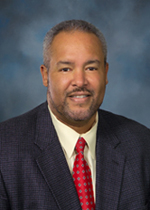 |
Rubens Pamies, M.D. |
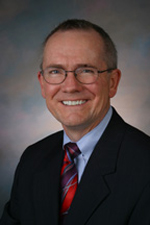 |
John Reinhardt, D.D.S. |
 |
John Gollan, M.D., Ph.D. |
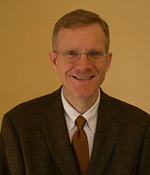 |
Courtney Fletcher, Pharm.D. |
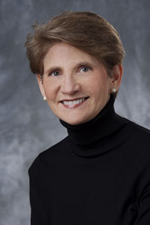 |
Virginia Tilden, D.N.Sc. |
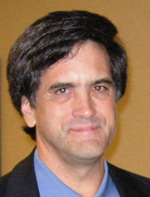 |
Keith Mueller, Ph.D. |
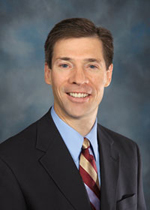 |
Kyle Meyer, Ph.D. |
Sizable increases occurred in both the Graduate College and in the professional level, which includes the colleges of dentistry, pharmacy and medicine and certain programs in the School of Allied Health Professions such as physician assistant and physical therapy.
Enrollment in the Graduate College climbed by 45 students, or 7 percent, going from 647 to 692. At the professional level, there was an increase of 37 students, or 2.2 percent, boosting the total of professional students from 1,652 to 1,689.
Rubens Pamies, M.D., vice chancellor for academic affairs and dean of graduate studies, said the continuing increase in enrollment at UNMC is attributable in large part to students wanting to get the best possible value for their educational dollars.
“Students are using a lot of different sources to make up their mind on where they go for their higher education,” Dr. Pamies said. “For in-state students, they look around and it’s easy for them to see that UNMC and the University of Nebraska are a good investment. They can get a world-class education here with world-class professors. It’s a great value. They can get a premium education without having to go elsewhere and pay much more money.
“By keeping their tuition costs low, students wind up with much smaller debts to repay when they complete their education. With all the hard economic times, decisions are being made on many factors, after which students realize what a great bargain an outstanding education at UNMC is.”
Listed below are enrollment highlights for 2008-09 for each of UNMC’s colleges as well as the School of Allied Health Professions:
College of Dentistry
The College of Dentistry brought in 45 first-year dental students as well as 24 new dental hygiene students, said Dean John Reinhardt, D.D.S. The new students bring total enrollment in the college to 263, including 33 graduate and post graduate students.
For 11 of the past 15 years, the first-year dental students at the UNMC College of Dentistry have ranked number one with the highest grade point average (GPA) among all U.S. dental schools. This year’s GPA for entering students is 3.77. The incoming students include seven who previously participated in the UNMC Summer Medical and Dental Education Program (SMDEP), a Robert Wood Johnson Foundation-supported program to attract students who represent communities or populations that are underserved or disadvantaged toward careers in medicine and dentistry.
Dr. Reinhardt noted that there were 1,016 applicants for the 45 slots in this year’s dental class, which consists of 23 men and 22 women. Thirteen of the new dental students have parents, grandparents, or siblings that are graduates of the college. The entering dental hygiene class had a 3.51 GPA and includes four students at the Panhandle Health Center in Gering, Neb.
College of Medicine
The 130 students in the College of Medicine’s class of first-year students brings total enrollment in the college to 482. The first-year students were selected from a total of 1,415 applications — the most applications received by the medical school since 1995, said John Gollan, M.D., Ph.D., dean of the College of Medicine.
“It’s an outstanding class of students with an overall grade point average of 3.71,” Dr. Gollan said. “This year, 46 students were admitted under an early decision process. The College of Medicine received an increase of 36 percent more applicants than during the prior year. This increased interest in the early decision process may be due to the quality of the educational programs and technology advanced facilities.”
College of Nursing
A total of 997 students across all nursing programs and campuses are enrolled this fall. Admission to the college continues to be highly competitive, said Virginia Tilden, D.N.Sc., dean of the UNMC College of Nursing. The college received 663 qualified applicants this year to the baccalaureate in nursing program for 310 slots across the college’s four divisions in Omaha, Lincoln, Kearney and Scottsbluff — an admission rate of 46 percent. The incoming students’ GPA is 3.5 based on students’ first two years of college.
The college’s accelerated baccalaureate in nursing program, now in its fourth year, had 81 applicants for 24 positions and an admitting GPA of 3.7. This program’s graduates have a 97 percent first-time pass rate on the National Licensing Board. Entry into the college’s graduate programs also is highly competitive, Dr. Tilden said, with the two most popular specialties, family nurse practitioner and acute care nurse practitioner, accepting less than 50 percent of qualified applicants.
“We continue to attract top-notch students into nursing and serve the state with multiple campuses and multiple programs ranging from the BSN through the Ph.D. in nursing. Like the rest of the country, we have stretched faculty and facilities in order to address the nursing shortage,” Dr. Tilden said.
College of Pharmacy
Sixty-five new students with a mean GPA of 3.64 were accepted into the College of Pharmacy’s Doctor of Pharmacy degree (Pharm.D.) program. These new first-year students bring the total enrollment in the four-year Pharm.D. program to 255 students.
Among the new first-year students, 86 percent are Nebraska residents with 51 percent of the students coming from outside Omaha and Lincoln, and 8 percent of the students being admitted via the College of Pharmacy’s rural student early acceptance program. The 14 percent of the students who are not from Nebraska come to the College of Pharmacy from as close as Iowa and as far away as Nairobi, Kenya. The breakdown of first-year students includes 66 percent female, 34 percent male, and 8 percent are minorities. Of the 65 incoming students, 43 percent have already received a prior bachelor or higher degree.
Courtney Fletcher, Pharm.D., dean of the College of Pharmacy, said, “This is an outstanding class of students. They will continue our 100-year legacy of excellence in pharmacy education at the University of Nebraska and in our pharmacist graduates meeting the pharmacy health care needs of the citizens of Nebraska.”
College of Public Health
Enrollment in the Master of Public Health program (MPH) is 88 students for the fall 2008-2009 semester, an 18 percent increase over the 2007-08 academic year. A total of 181 students have enrolled in the MPH program since its beginning in 2002, said Keith Mueller, Ph.D., interim dean of the College of Public Health.
There were 63 applicants to the MPH program this year of which 44 were accepted. Dr. Mueller said this year’s admission pool has the following characteristics: mean GPA 3.54, 79 percent females, 21 percent males, 30 percent minority, and an average of 3.7 years of previous work experience. Of the 44 applicants accepted to the MPH program, 68 percent were Nebraska residents, 16 percent were from a U.S. state other than Nebraska, and 16 percent were international.
School of Allied Health Professions
Total enrollment for the School of Allied Health Professions in 2008-09 is 351 students. The SAHP offers 10 educational programs that prepare graduates for careers as cytotechnologists, clinical laboratory scientists, clinical perfusionists, diagnostic medical sonographers, medical nutritionists, nuclear medicine technologists, physician assistants, physical therapists, radiographers and radiation therapists.
Highlights this year included: 170 students in the 10 programs with a mean GPA of 3.56, 74 percent females, 26 percent males, 82 percent residents, 18 percent non-residents, and seven students entering the clinical perfusion education program equals the largest entering class since 2001 (there were also seven students in 2001).
A total of 13 students (eight clinical laboratory science students and five radiography students) are placed throughout Nebraska for their education. They participate in lecture classes via distance education while conducting the clinical component of their education at sites in Columbus, Grand Island, Hastings, Kearney, Norfolk and North Platte.